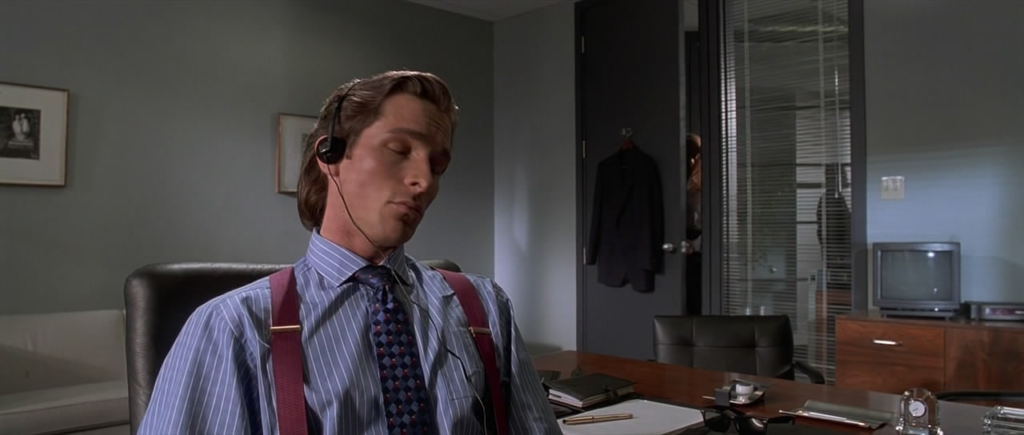To Read or Not to Read: Bret Easton Ellis’s American Psycho
by Peyton Trout
This review contains spoilers for the film and book.

A Halloween costume classic. A TikTok trend. A crazed businessman. Patrick Bateman has had a grip on pop culture more in recent years than ever before. While most everyone knows Christian Bale as Patrick Bateman from the classic horror-comedy film that came out in 2000, Bret Easton Ellis’s haunting novel about Bateman reaches far deeper that an hour and a half movie ever could.
Regarding book-to-film adaptations, American Psycho is one of the best. The characters are fully represented, the dialogue nearly word-for-word, and Bateman’s toxicity and insufferable personality are extremely well-represented. The movie is widely quoted, has a star-studded cast, and gets the point of the book across well for its short time frame. While Bateman’s every thought and action in the film is seen as comedic, Ellis’s portrayal of him in the book is anxiety-inducing and horrifying.
Ellis’s 400-page novel is by no means an easy, fun read, and it starts the same way it ends: ambiguous. When going into the novel, the reader knows the main character is Bateman, but the first few pages put us in a state of confusion. Many characters are speaking and being referred to, but none are referring to Bateman’s character. The first 80-100 pages are slow and leave the reader subject to only Bateman’s phony interactions with others, his multiple-page internal monologues about bands and artists he loves (delving into their entire discographies), and, famously, his far-too-long morning routine.

The beginning is slow, so slow I took a two month break from reading it after 40 pages and almost didn’t finish it. Bateman’s character is insufferable, but he has his funny moments admiring finishes on business cards, criticizing his coworkers and girlfriend(s), cataloging what everyone is wearing at all times.
I implore you to push through the first third of this book. It is difficult and you will want to give up and you will despise Patrick Bateman more in these pages than you ever thought possible. Our first glimmer of plot-progression hope is when the book alludes to his murders in the Chinese dry cleaners (shown in the movie) where he frantically tries to “reason” with the owner to get blood stains out of his sheets, calling it cranberry juice. After this incident, Ellis documents Bateman’s first kill on paper, and oh boy does the novel pick up, and quick. The killing of the homeless man and the wounding of his dog is documented in the movie, and these are by no means Bateman’s first crimes. It is here the reader realizes Bateman truly is experienced at killing.
After the kill of the homeless man, Ellis makes the switch from anal and annoying to full-blown psychotic behavior. Bateman hires prostitutes to torture, forces them upon each other, and, eventually, brutally (and I mean brutally) kills them. The murders are gruesome and intensely detailed. From grotesque sexual activity to horrific, stomach twisting murders that you could have never imagined.

Bateman spirals amidst the murders. Sequences of him frantically running throughout New York City, sweating through, and ripping of his jackets, going from a corner store to Bloomingdale’s, shoving different cocktails of pills down his throat, shouting slurs and running into passersby all make for a confusing, insightful look into who Patrick Bateman is. The ragged running devolves into a skillfully documented killing spree of Bateman’s late in the novel. Police chase him all through the boroughs of New York as he stabs and shoots innumerable innocent people and a cop. This is the only part in the novel where the point of view shifts from first person to close third person. This jolting change leaves the reader even more detached from Bateman and his actions, showing how mad he really is during this killing spree. The scene ends with him running into the building where he works and emotionally admitting his crimes to his therapist’s voicemail box.
The novel ends ambiguously. Bateman goes into the apartment of Paul Owen (re-named Paul Allen in the film) where he was supposed to have killed Owen and multiple women – who were stuffed in every closet and free space available – only to find a real estate agent who knew no one by the name Paul Owen living there before. Along with this, the person Bateman confessed his crimes to thinks he was joking, and the reader is left wondering whether they were just subject to Patrick Bateman’s sick internal fantasies or if he really did commit those murders.
So, if the question is “to read or not to read”, I will say move forward with caution. As a woman, the killing of Bateman’s prostitutes and escorts made me sick to my stomach alongside the fact that he was doing this as a game, for no reason except as a product of his own psychosis. I am not an experienced horror reader, so that also plays into my recommendation of the book. I think those who have seen the movie and are thinking of reading the book should not expect a fun, horror-comedy type of book, but need to be prepared for an increasingly disturbing and jarring 400-page depiction of a madman.
Bret Easton Ellis expertly shows how words on a page can form into a mind-altering and stomach-twisting tale of a demented businessman working on Wall Street. Truly a masterpiece if there ever was one.
Image sources (in order of appearance):
steamDB, u/[deleted] on Reddit, head-fi.org, litsnaps.tumblr.com